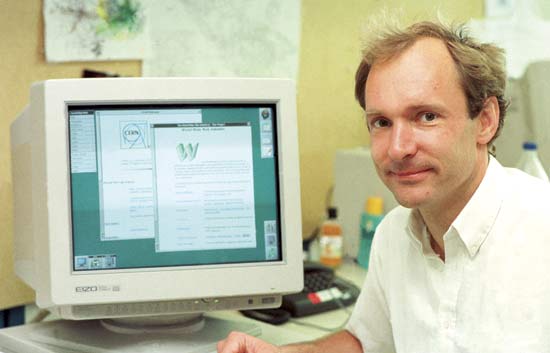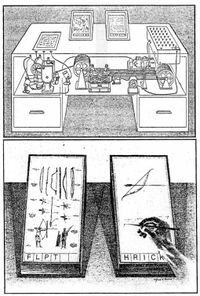Null/HTML: Difference between revisions
No edit summary |
|||
| Line 32: | Line 32: | ||
"''Suppose all the information stored in computers everywhere were linked … Suppose I could program my computer to create a space in which anything could be linked to anything.'' All the bits of information in every computer at CERN, and on the planel, would be available to me and anyone else. These would be a single information space"<ref name=WeavingtheWeb/>. | "''Suppose all the information stored in computers everywhere were linked … Suppose I could program my computer to create a space in which anything could be linked to anything.'' All the bits of information in every computer at CERN, and on the planel, would be available to me and anyone else. These would be a single information space"<ref name=WeavingtheWeb/>. | ||
"In Enquire I could type in a page of information about a person, a device or a program. Each page was a ‘node’ in the program, a little like an index card. The only way to create a new node was to make '''a link''' from and old node"<ref name=WeavingtheWeb/>. | |||
Although unaware, Berner's Lee was venturing into territory previously explored by others. | Although unaware, Berner's Lee was venturing into territory previously explored by others. | ||
| Line 46: | Line 48: | ||
* reference to text | * reference to text | ||
=== How? === | |||
:steps after ENQUIRE | |||
==== Hypertext ==== | |||
Berners-Lee was looking for a minimal approach the wouldn't force anyone at CERN to change the software, hardware or formats they were using. | |||
He chose '''hypertext''', and expand it, by moving beyond internal links, like those of Enquire, to '''external link''', that would allow jumps between different information spaces. | |||
==== links: anchors ==== | |||
==== HTML ==== | |||
== what is HTML? == | == what is HTML? == | ||
Revision as of 22:59, 26 October 2014
HTML and the Web
A bit of history: the Wold Wide Web
HTML developed from the creation of the Wold Wide Web
what ?
The Wold Wide Web, AKA www, AKA the Web is not the Internet.
The Internet is essentially the motorway where many vehicles (or protocols) circulate, the Web is simply one, but a very popular one. Others vehicles on the Internet are email, FTP, torrents, IRC chat, etc.
The Web is a network of interlinked pages, that are accessible through a Web Browser.
The vision for what would become the Web came from the British computer scientist Tim Berners-Lee who happened to be working at CERN in the late 1980s
why ?
As Tim Berners-Lee was working as a software developer at CERN he was faced with a few facts that would make him muse about what would later become the Web. These fact were:
- CERN's incredible abundance of knowledge and research
- CERN's equally abundance of different computer hardware/software, protocols, file formats, documentation systems
- == a bloody mess
Berners-Lee wanted to create some unified, global documentation system, that allowed CERN research team to document and share their progress in ways that would be readable, but also writable to others.
Berners-Lee's first efforts went to the development of a program called ENQUIRE, a pet project to help him remember the connections among the various people, computers and projects at CERN.
This first experiment got him thinking:
"Suppose all the information stored in computers everywhere were linked … Suppose I could program my computer to create a space in which anything could be linked to anything. All the bits of information in every computer at CERN, and on the planel, would be available to me and anyone else. These would be a single information space"[1].
"In Enquire I could type in a page of information about a person, a device or a program. Each page was a ‘node’ in the program, a little like an index card. The only way to create a new node was to make a link from and old node"[1].
Although unaware, Berner's Lee was venturing into territory previously explored by others.
Vannevar Bush: the Memex
The Memex ...
- reference to 'As We May Think'
- …
Ted Nelson: Project Xanadu
- …
- inventor of hypertext
- reference to text
How?
- steps after ENQUIRE
Hypertext
Berners-Lee was looking for a minimal approach the wouldn't force anyone at CERN to change the software, hardware or formats they were using.
He chose hypertext, and expand it, by moving beyond internal links, like those of Enquire, to external link, that would allow jumps between different information spaces.
links: anchors
HTML
what is HTML?
HTML stands for HyperText Markup Language.
It is the most popular publishing language for the Web, but is also used as a source for ePubs.
In essence HTML is a descriptive markup language[2]. The markup of HTML tags describes to the browser on how text, images (, video, audio) should be displayed on the screen.


